- Home
- About
- Map
- Trips
- Bringing Boat West
- Migration West
- Solo Motorcycle Ride
- Final Family XC Trip
- Colorado Rockies
- Graduates' XC Trip
- Yosemite & Nevada
- Colorado & Utah
- Best of Utah
- Southern Loop
- Pacific Northwest
- Northern Loop
- Los Angeles to NYC
- East Coast Trips
- 1 Week in Quebec
- Southeast Coast
- NH Backpacking
- Martha's Vineyard
- Canadian Maritimes
- Ocracoke Island
- Edisto Island
- First Landing '02
- Hunting Island '02
- Stowe in Winter
- Hunting Island '01
- Lake Placid
- Chesapeake
- Provincetown
- Hunting Island '00
- Acadia in Winter
- Boston Suburbs
- Niagara Falls
- First Landing '99
- Cape Hatteras
- West Coast Trips
- Colorado River Rafting
- Bishop & Death Valley
- Kauai
- Yosemite Fall
- Utah Off-Road
- Lost Coast
- Yosemite Valley
- Arizona and New Mexico
- Pescadero & Capitola
- Bishop & Death Valley
- San Diego, Anza Borrego, Joshua Tree
- Carmel
- Death Valley in Fall
- Yosemite in the Fall
- Pacific Northwest
- Utah Off-Roading
- Southern CA Deserts
- Yosemite & Covid
- Lake Powell Covid
- Eastern Sierra & Covid
- Bishop & Death Valley
- Central & SE Oregon
- Mojave Road
- Eastern Sierra
- Trinity Alps
- Tuolumne Meadows
- Lake Powell Boating
- Eastern Sierra
- Yosemite Winter
- Hawaii
- 4WD Eastern Sierra
- 4WD Death Valley +
- Southern CA Deserts
- Christmas in Tahoe
- Yosemite & Pinnacles
- Totality
- Yosemite & Sierra
- Yosemite Christmas
- Yosemite, San Diego
- Yosemite & North CA
- Seattle to Sierra
- Southwest Deserts
- Yosemite & Sierra
- Pacific Northwest
- Yosemite & South CA
- Pacific Northwest
- Northern California
- Southern Alaska
- Vancouver Island
- International Trips
- Index
- Tips
- Books
- Photos/Videos
- Search
- Contact
Getty Museums
Thursday, December 5, 2013 - 10:45am by Lolo48 miles and 1 hour from our last stop
Travelogue
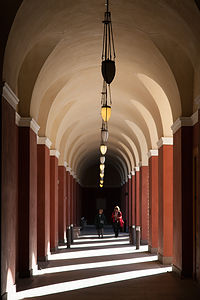 Getty Villa ArchesFirst word of caution: Do not use your GPS to find the Getty Villa, because it will lead you to the wrong entrance. We almost missed our scheduled tour because we wasted close to a ½ hour listening to ours. Instead follow the directions on their website.
Getty Villa ArchesFirst word of caution: Do not use your GPS to find the Getty Villa, because it will lead you to the wrong entrance. We almost missed our scheduled tour because we wasted close to a ½ hour listening to ours. Instead follow the directions on their website.
Although the museum is free, you do need to reserve a time slot ahead of time, which we did the previous day. Parking, however, is $15, but if you save your receipt you can use it to get free parking at the Getty Center on the same day. Do not even think about bringing an RV to this parking lot. If you have no other option, use public transportation as suggested on their website.
The Getty Villa’s collection is dedicated to ancient Etruscan, Greek, and Roman art and artifacts, which are appropriately displayed in a replica of the Villa dei Papiri in Herculaneum, an ancient Roman country estate buried by the A.D. 79 Mount Vesuvius eruption. The entire grounds of the museum are made to simulate an archeological dig, with each building at a slightly different elevation, allowing visitors to make new discoveries with each perspective.
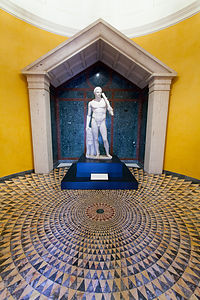 Getty Villa HerculesAlthough we could have explored the museum on our own, we signed up for a docent tour of the museum and gardens, something I very highly recommend. It was very well worth it, and despite the large group, everyone could hear the docent clearly, because we were given headphones that picked up the audio output of his microphone. You knew you were wondering too far from the group if you started to hear static.
Getty Villa HerculesAlthough we could have explored the museum on our own, we signed up for a docent tour of the museum and gardens, something I very highly recommend. It was very well worth it, and despite the large group, everyone could hear the docent clearly, because we were given headphones that picked up the audio output of his microphone. You knew you were wondering too far from the group if you started to hear static.
While the artworks in the interior of the museum were interesting and impressive, I enjoyed wandering through the gardens even more. The largest and most beautiful of these is the Outer Peristyle, where a covered walkway surrounds the formal garden and a spectacular 220-foot reflecting pool. The plants grown in the garden were those that would be found in an ancient Roman garden, such as oleander, boxwood, bay laurel, myrtle, and ivy. There are also wonderful views of the sea from the end of the pool.
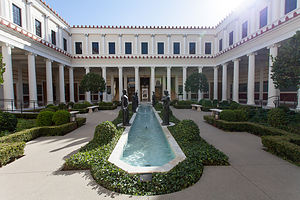 Getty Villa CourtyardOne of the museum security guards told us of a secret door where we could view the Outer Peristyle from the 2nd story of the Villa. I’m not sure that it was all that much of a secret, as there were others doing the same, but it did give a lovely perspective of the reflecting pool, the surrounding gardens and statues, and the Pacific Ocean beyond.
Getty Villa CourtyardOne of the museum security guards told us of a secret door where we could view the Outer Peristyle from the 2nd story of the Villa. I’m not sure that it was all that much of a secret, as there were others doing the same, but it did give a lovely perspective of the reflecting pool, the surrounding gardens and statues, and the Pacific Ocean beyond.
We could easily have spent the entire day at the Villa, but while in the area, we also wanted to see the Getty Center, and since we had our parking receipt, it would be totally free if we went today. That way we wouldn’t feel bad if we didn’t have enough time to give it true justice. We could always come back again to see what we missed.
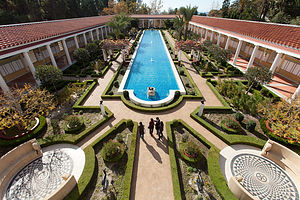 Getty Villa Outer PeristyleInstead of going highways to get there, we drove the much slower and windy Sunset Boulevard to get from the Pacific Coast Highway through the Brentwood section of Los Angeles to the museum. I’m sure it was a much more interesting drive than I405.
Getty Villa Outer PeristyleInstead of going highways to get there, we drove the much slower and windy Sunset Boulevard to get from the Pacific Coast Highway through the Brentwood section of Los Angeles to the museum. I’m sure it was a much more interesting drive than I405.
As mentioned, the Getty Center is a totally different experience from that of the Getty Villa. Firstly, the makeup of its collections varies greatly. While the Villa focuses on ancient Etruscan, Greek, and Roman Art, the Getty Center collection consists of pre-20th-century European paintings, drawings, illuminated manuscripts, sculpture, and decorative arts; 17th and 18th century French furniture and decorative arts; and 19th and 20th century American, Asian, and European photographs.
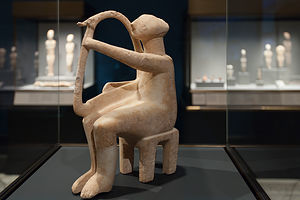 Getty Villa Cycladic Harp PlayerBesides the dissimilarity of the collections between the two Getty museums, the environment in which they are experienced is also totally different, the Getty Villa being ancient and intimate, and the Getty Center modernistic and expansive.
Getty Villa Cycladic Harp PlayerBesides the dissimilarity of the collections between the two Getty museums, the environment in which they are experienced is also totally different, the Getty Villa being ancient and intimate, and the Getty Center modernistic and expansive.
When we arrived at the Getty Center, we parked our car at the base of the hill and boarded a computerized unmanned tram, which swept us to the top of a hill, and then discharged us onto a central arrival plaza, at the base of a set of stairs leading up to the museum entrance. Very futuristic.
The first thing we did was enter the museum to pick up the free audio tour headsets and sign up for a docent-led tour. When you only have a short time at the Getty Center, you really have to choose whether you want to concentrate on the art collection or the architectural design of the campus. We decided to go for the architectural tour and then explore a few of the art exhibits on our own afterwards.
So first, the architecture….
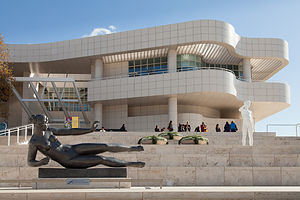 Getty Center Main EntranceThe Getty Center was designed by the world-renowned architect Richard Meier. It was he who was given the challenging task of designing a museum complex atop a hill in the Santa Monica Mountains that would do justice to this incredible landscape setting and panoramic views of Los Angeles, the San Bernardino and San Gabriel Mountains, and the Pacific Ocean.
Getty Center Main EntranceThe Getty Center was designed by the world-renowned architect Richard Meier. It was he who was given the challenging task of designing a museum complex atop a hill in the Santa Monica Mountains that would do justice to this incredible landscape setting and panoramic views of Los Angeles, the San Bernardino and San Gabriel Mountains, and the Pacific Ocean.
The complex not only had to house the museum’s permanent art collection, but also the business offices of the Getty Research Institute, Getty Foundation, Getty Conservation Institute, and J. Paul Getty Trust.
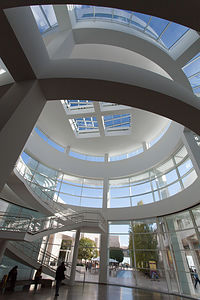 Getty Center FoyerThe publicly accessible part lies on the ocean side of the Museum Entrance Hall. It consists of a courtyard surrounded by five, interconnected, two-story pavilions, which house the museum’s art collection. The upper level of each pavilion displays paintings, while the plaza level displays sculpture, decorative arts, and illuminated manuscripts.
Getty Center FoyerThe publicly accessible part lies on the ocean side of the Museum Entrance Hall. It consists of a courtyard surrounded by five, interconnected, two-story pavilions, which house the museum’s art collection. The upper level of each pavilion displays paintings, while the plaza level displays sculpture, decorative arts, and illuminated manuscripts.
Natural lighting is an important architectural element used by Meier. Much of the exterior walls of the pavilions are made of glass, allowing sunlight to illuminate the interior. Upper level galleries are all naturally lit through a computerized system of shades and louvers that control the intensity and quality of sunlight that enters.
One of the many unifying elements of the design is the use of Italian travertine stone panels throughout the entire campus. These beige-colored, texture panels not only cover the walls and bases of all the buildings, but serve as paving stones in the courtyard as well. There is very little color when you look around the campus. The grid-like pattern created by the travertine squares is softened a bit by the curvilinear design incorporated into the buildings.
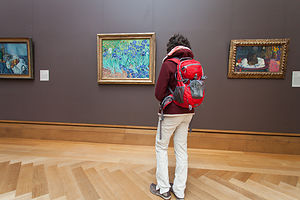 Lolo with Van Gogh’s IrisesThroughout the terraces and gardens, there are more than 28 contemporary and modern sculptures on display. We recognized several by the artist Mark di Suvero, whose work we have admired in Crissy Field in San Francisco the Olympic Sculpture Park in Seattle, and the Storm King Art Center in New York State. .
Lolo with Van Gogh’s IrisesThroughout the terraces and gardens, there are more than 28 contemporary and modern sculptures on display. We recognized several by the artist Mark di Suvero, whose work we have admired in Crissy Field in San Francisco the Olympic Sculpture Park in Seattle, and the Storm King Art Center in New York State. .
After the tour was over, we did an embarrassingly quick run through of a few of the pavilions, telling ourselves that we would come back at a future date and enjoy the exhibits at a more leisurely pace.
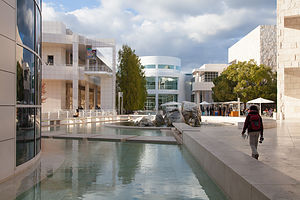 Getty Center CourtyardOur last stop before catching the tram back down the hill was to the South Promontory cactus garden, where we took in the wonderful panoramic views of the city of Los Angeles, the San Bernardino and San Gabriel Mountains, and the Pacific Ocean.
Getty Center CourtyardOur last stop before catching the tram back down the hill was to the South Promontory cactus garden, where we took in the wonderful panoramic views of the city of Los Angeles, the San Bernardino and San Gabriel Mountains, and the Pacific Ocean.
It would be very difficult to say which Getty Museum I enjoyed more, as they are both so very different. However, I would have to say that I had a slight leaning towards the Getty Villa, as I tend to love history and smaller, intimate settings, while Herb had a slight leaning toward the Getty Center, as his engineering background gives him a better understanding and appreciation of the architectural design and modernism.
Let’s just say we were lucky to have had the time to see them both.
Description
Getty Villa
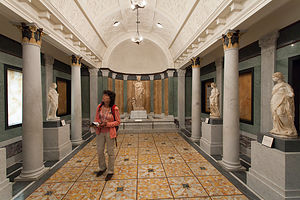 Lolo in Getty Villa ExhibitThe Getty Villa is one of two locations of the J. Paul Getty Museum, the other one being the Getty Center in Los Angeles. The Villa is located in Pacific Palisades, just south of Malibu, and sits atop a bluff overlooking the ocean.
Lolo in Getty Villa ExhibitThe Getty Villa is one of two locations of the J. Paul Getty Museum, the other one being the Getty Center in Los Angeles. The Villa is located in Pacific Palisades, just south of Malibu, and sits atop a bluff overlooking the ocean.
The major focus of the Getty Villa is ancient Etruscan, Greek, and Roman art, and the collection includes over 44,000 works dating from 6,500 B.C. to A.D. 400. 1,200 of them are on display in 23 galleries devoted to the permanent collection. There has been some controversy concerning the acquisition and rightful ownership of some of the works, and in 2006, the Getty returned several looted items to the Greek and Italian governments.
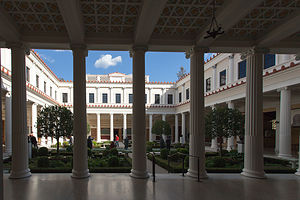 Getty Villa CourtyardVery appropriately, the collection is housed in a building modeled after the Villa dei Papiri in Herculaneum, a first-century Roman country house buried in the A.D. 79 eruption of Mount Vesuvius. It first opened to the public in 1974. Getty, who died shortly afterwards in 1976, never actually visited the museum after it was opened.
Getty Villa CourtyardVery appropriately, the collection is housed in a building modeled after the Villa dei Papiri in Herculaneum, a first-century Roman country house buried in the A.D. 79 eruption of Mount Vesuvius. It first opened to the public in 1974. Getty, who died shortly afterwards in 1976, never actually visited the museum after it was opened.
The Villa was closed to the public during a $275 million, 8 year renovation which went on from 1998 until its reopening in 2006.
The architectural plan surrounding the villa was designed to simulate an archaeological dig. With each building at a slightly different elevation, visitors experience the site as an archaeological excavation, with each perspective offering new discoveries.
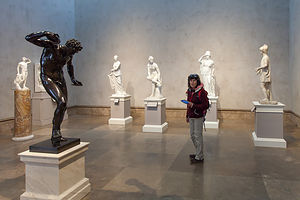 Lolo with Getty Center Roman StatuesJust as in ancient Roman homes, gardens are an integral part of the setting and include plants that were favored by the ancient Romans, such as oleander, boxwood, bay laurel, myrtle, and ivy. The largest and most beautiful of these gardens is the Outer Peristyle, where a covered walkway surrounds the formal garden and a spectacular 220-foot reflecting pool.
Lolo with Getty Center Roman StatuesJust as in ancient Roman homes, gardens are an integral part of the setting and include plants that were favored by the ancient Romans, such as oleander, boxwood, bay laurel, myrtle, and ivy. The largest and most beautiful of these gardens is the Outer Peristyle, where a covered walkway surrounds the formal garden and a spectacular 220-foot reflecting pool.
Admission is free, but visitors must reserve tickets ahead of time for a specific time. There is a $15 charge for parking. If you visit the Getty Center the same day, your parking receipt from the Villa will work at the Center. Note: the parking lot cannot accommodate RVs.
When touring the Getty Villa, be sure to join one of the very informative docent tours of the museum and gardens.
Getty Center
Getty Center
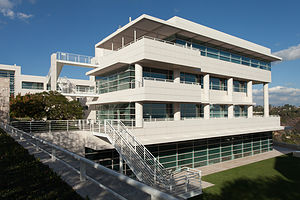 Getty Center ComplexThe Getty Center, the second of the two locations of the J. P. Getty Museum, sits atop a hill in the Santa Monica Mountains, with panoramic views of Los Angeles, the San Bernardino and San Gabriel Mountains, and the Pacific Ocean.
Getty Center ComplexThe Getty Center, the second of the two locations of the J. P. Getty Museum, sits atop a hill in the Santa Monica Mountains, with panoramic views of Los Angeles, the San Bernardino and San Gabriel Mountains, and the Pacific Ocean.
Inspired by the landscape which enfolds below, famed architect Richard Meier designed the complex to highlight both nature and culture. The campus is organized around a central arrival plaza, where visitors disembark from a computer-operated tram that begins at the bottom of the hill.
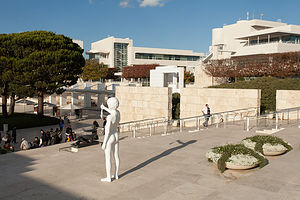 Getty Center Entrance StairsOne of the many unifying elements of the design is the use of Italian travertine stone panels, which covers not only the walls and bases of all buildings, but also serves as paving stones in the museum courtyard. This beige-colored, textured stone reflects sunlight during the morning and emits a honeyed warmth in the afternoon. The curvilinear design incorporated into the buildings help soften the grid created by the travertine squares.
Getty Center Entrance StairsOne of the many unifying elements of the design is the use of Italian travertine stone panels, which covers not only the walls and bases of all buildings, but also serves as paving stones in the museum courtyard. This beige-colored, textured stone reflects sunlight during the morning and emits a honeyed warmth in the afternoon. The curvilinear design incorporated into the buildings help soften the grid created by the travertine squares.
Natural lighting is another important architectural element used by Meier. Much of the exterior walls of the pavilions are made of glass, allowing sunlight to illuminate the interior. Upper level galleries are all naturally lit through a computerized system of shades and louvers that control the intensity and quality of sunlight that enters.
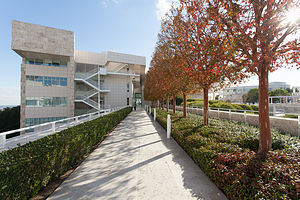 Getty Center WalkwayThe museum is comprised of five interconnected, two-story pavilions surrounding a central courtyard. Inside the pavilion are the galleries for the permanent collection of pre-20th-century European paintings, drawings, illuminated manuscripts, sculpture, and decorative arts; 17th and 18th century French furniture and decorative arts; and 19th and 20th century American, Asian, and European photographs.
Getty Center WalkwayThe museum is comprised of five interconnected, two-story pavilions surrounding a central courtyard. Inside the pavilion are the galleries for the permanent collection of pre-20th-century European paintings, drawings, illuminated manuscripts, sculpture, and decorative arts; 17th and 18th century French furniture and decorative arts; and 19th and 20th century American, Asian, and European photographs.
Contemporary and modern sculpture is featured throughout the terraces and gardens, including 28 modern and contemporary outdoor sculptures of artists such as Mark di Suvero.
The heart of the Getty Center is Robert Irwin’s Central Garden, a 134,000 square foot design featuring a natural ravine and a tree-lined walkway that traverses a stream and gradually descends to a plaza where the stream cascades over a stone waterfall into a pool with a floating maze of azaleas.
The Getty Center is also home to the Getty Research Institute, Getty Foundation, Getty Conservation Institute, and J. Paul Getty Trust.
Admission to the Getty Center is free, although parking costs $15.
San Francisco RV Resort - Pacifica
Sunday, December 1, 2013 - 12:45pm by Lolo205 miles and 5 hours from our last stop - 1 night stay
Travelogue
Here we were back in our San Francisco south base camp. Since we had dilly dallied as long as we could in Yosemite this morning, we got back here pretty late – much too late to watch sunset over the sea. In fact, much too late to do much of anything, except drive Andrew back up to the city and come back and go to bed.
Tommy’s flight back to Seattle was 6:30 in the morning, so the next morning we arose at the ungodly hour of 5:00 and drove him to the airport. After a short nap and breakfast, Herb and I set out on our own once again to explore a bit of Southern California.
Description
The San Francisco RV Resort is located in the town of Pacifica, 15 miles south of Golden Gate Bridge. Besides being the closest RV camping to San Francisco, it is also one of the best RV parks in the Bay Area. Situated atop a 60-foot bluff, it is the only campground in the Bay area to offer oceanfront sites and daily dramatic sunsets.
There are 162 sites on paved, level asphalt. All sites, except the ocean sites, have full hookups and cable TV. Ocean sites have no hookups, but all campsites have free WiFi. Other amenities include a heated pool and spa, beach access, and a nearby fishing pier.
The sites range in price from $61 per night for an ocean, non hookup site, to $69 for full hookup. The campground is open all year round.
Flight Home
Thursday, December 12, 2013 - 1:00pm by Lolo55 miles and 1.25 hours from our last stop - 1 night stay
Travelogue
We had the routine down now. Petaluma Taxi to the Petaluma Fairgrounds to catch the Sonoma County Shuttle to the airport. It felt a little like we were leaving home. I guess we really were becoming bicoastal.
Description
The Sonoma County Airport Express runs shuttles to the airport every hour from several locations: the Park and Ride in Santa Rosa, the Doubletree Hotel in Rohnert Park, and the Petaluma Fairgrounds. Fares are $34 each way.
San Francisco North / Petaluma KOA
Tuesday, December 10, 2013 - 1:00pm by Lolo51 miles and 1.25 hours from our last stop - 2 night stay
Travelogue
Thank goodness for Amazon. The replacement for the Subaru passenger side mirror that we had smashed two weeks ago when we dropped the kayak on it had arrived addressed to us at the Petaluma KOA. This was really starting to feel like home.
Replacing it took us (and by us, I mean Herb) a lot longer than we thought because the whole car door pretty much had to be taken apart. While he did that, I did loads and loads of laundry so that everything left behind, as well as everything we brought home, would be nice and clean.
We really had brought too much stuff out with us this time. It was getting harder and harder to remember what lived in New Jersey and what lived in California, so we spent some time organizing and making an inventory of our stuff – not exactly very exciting, and probably even less exciting to read about.
The next morning we tucked the motorhome back in its storage spot and headed for the airport.
Description
The Petaluma KOA is an award winning camping resort located within an hour’s drive of San Francisco, Napa and Sonoma Valley Wineries, giant redwoods, and Sonoma County and California Coastal Beaches. It is considered to be the RV resort in the San Francisco Bay area.
On its 70 acres, there are 312 spacious RV sites, 32 camping cabins, and 10 Wine Country lodges.
Other amenities include:
• Guided tours of San Francisco (from May through October)
• Huge heated pool and spa
• Inflatable waterslide
• Rock climbing wall
• Huge playground
• Petting zoo
• Karaoke
• Hayrides and live weekend entertainment
The campground is open all year.
San Francisco RV Resort - Pacifica
Monday, December 9, 2013 - 12:15pm by Lolo242 miles and 5 hours from our last stop - 1 night stay
Travelogue
 Herb and Lolo camping at PacificaThis was actually our third time this trip that we camped in Pacifica. We were flying back home to New Jersey soon and had to get back to the Petaluma KOA to prep and store the motorhome, but we figured we could squeeze one more quick visit with Andrew and Celeste en route. This campground really is extremely convenient for getting in and out of San Francisco.
Herb and Lolo camping at PacificaThis was actually our third time this trip that we camped in Pacifica. We were flying back home to New Jersey soon and had to get back to the Petaluma KOA to prep and store the motorhome, but we figured we could squeeze one more quick visit with Andrew and Celeste en route. This campground really is extremely convenient for getting in and out of San Francisco.
No rock climbing this time. They didn’t know we would be coming by, so they had climbed pretty hard the day before and needed a day off. Instead we just hung out at their apartment for awhile, enjoying the festiveness of their Charlie Brown Christmas tree – so, so cute. Even a two-foot deformed tree costs over $20 in San Francisco.
We walked to dinner at Gespare’s, an Italian restaurant over on Geary Street. It’s so great that they have such a variety of options for dining out, all within walking distance.
Well, it was goodbye for now. The next time we would see Andrew and Tommy would be when they came home for Christmas. I wasn’t sure when we would see Celeste next, as she would be spending Christmas with her family in Vancouver.
Always tough to part, but easier knowing that it wouldn’t be too long.
Description
The San Francisco RV Resort is located in the town of Pacifica, 15 miles south of Golden Gate Bridge. Besides being the closest RV camping to San Francisco, it is also one of the best RV parks in the Bay Area. Situated atop a 60-foot bluff, it is the only campground in the Bay area to offer oceanfront sites and daily dramatic sunsets.
There are 162 sites on paved, level asphalt. All sites, except the ocean sites, have full hookups and cable TV. Ocean sites have no hookups, but all campsites have free WiFi. Other amenities include a heated pool and spa, beach access, and a nearby fishing pier.
The sites range in price from $61 per night for an ocean, non hookup site, to $69 for full hookup. The campground is open all year round.
Port San Luis Harbor Campground - Avila Beach
Sunday, December 8, 2013 - 12:15pm by Lolo305 miles and 6 hours from our last stop - 1 night stay
Travelogue
 Lazy Daze at Port San Luis Harbor CampgroundWe were headed north again on our way back to San Francisco. Unfortunately, the unseasonably cold temperatures, big winds, and even rain had forced us to switch gears in Southern California. Rather than beaching and kayaking, we spent our time visiting museums and just generally sightseeing instead. At least we knew a lot more about where we would like to go and what we would like to do on future trips in hopefully better weather.
Lazy Daze at Port San Luis Harbor CampgroundWe were headed north again on our way back to San Francisco. Unfortunately, the unseasonably cold temperatures, big winds, and even rain had forced us to switch gears in Southern California. Rather than beaching and kayaking, we spent our time visiting museums and just generally sightseeing instead. At least we knew a lot more about where we would like to go and what we would like to do on future trips in hopefully better weather.
One stop we had briefly made on our drive down the coast was the town of Avila Beach, just 10 miles southwest of San Luis Obispo. It was written up in the guidebooks as a great beach town, with a beautiful sandy beach on San Luis Obispo Bay, nearby natural mineral hot springs to soak in, and a climate less foggy than most because it faces south into the ocean. In fact, before we left on this trip, I had tried to make a reservation at the Avila Hot Springs Spa and RV Park, only to find that the campground was temporarily closed for renovations.
While there, we drove to the end of the cove to the Port San Luis Wharf, which is an active and bustling commercial fishing base. To our surprise, just near the end of Avila Beach Drive we found two small turnouts with RVs camping right on the beach. We stopped to talk to one camper who told us this was one of the few spots on the California coast that you could actually camp this close to the beach, and he added, it was not written up in any of the campground guides. He was right. I checked afterwards. It was a bit of a well-kept secret, and he didn’t look particularly happy about sharing this information. Right now there were only a couple of RVs camping, as it was mid-week and the weather was really pretty cold, but I can imagine that on a warm weekend this place fills up fast.
Anyway, to make a long story short, on our drive back up the coast we came back here to camp for the night. Too bad it was so cold. We literally had to wear the down jackets we brought for the Yosemite portion of our trip. The furthest I got outside was to the self-registration box to deposit our $40 camping fee.
By the time that was done, it was already dark, but the view out our back window of the twinkling lights along the wharf made me happy.
Description
Avila Beach is located on San Luis Obispo Bay, just 10 miles southwest of the town of San Luis Obispo. Its major attraction is its beautiful sandy shoreline, protected waters, and lovely climate. Since it faces south into the ocean, its gets less fog than any other stretch of coastline in the area.
The Port San Luis Wharf, at the far end of the cove, is a base for commercial fishing boats, who dock each day to unload their catch. Fresh seafood can be gotten from several food shacks and fish markets on the pier. A colony of sea lions lives below the pier.
For $40 per night RVs can dry camp at one of the two turnouts near the pier, right on the ocean. $60 full hookups are available closer to the pier, and a bit further from the water. The campgrounds are operated by the Port San Luis Harbor District.
Campland on the Bay and San Diego Side Trips
Friday, December 6, 2013 - 12:00pm by Lolo178 miles and 3.5 hours from our last stop - 2 night stay
Travelogue
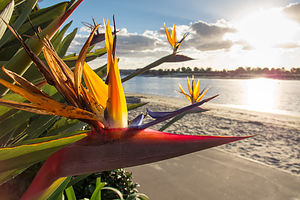 Mission Bay Birds of ParadisePoor Herb. He had so much been looking forward to the San Diego portion of our trip -- so had I for that matter, but he is much more of a sun worshipper and beachgoer than me. But alas, the weather was just not going to cooperate. Not only had a cold front that was making national news moved in, but it was forecast to rain during our stay as well. We were determined to make the best of it and chalk it up to an exploratory for future visits.
Mission Bay Birds of ParadisePoor Herb. He had so much been looking forward to the San Diego portion of our trip -- so had I for that matter, but he is much more of a sun worshipper and beachgoer than me. But alas, the weather was just not going to cooperate. Not only had a cold front that was making national news moved in, but it was forecast to rain during our stay as well. We were determined to make the best of it and chalk it up to an exploratory for future visits.
We did find a great campground called Campland on the Bay, located right on beautiful Mission Bay. The campground was huge -- over 550 campsites, two pools and Jacuzzis, and a fitness room with top-notch exercise equipment. Plus, they have their own sandy beach on Mission Bay and a marina that rents powerboats, jet skis, and kayaks.
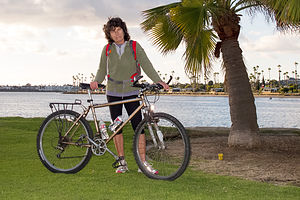 Bicycling Along Mission BayAs soon as we arrived, we hopped on our bikes to take advantage of the fact that it wasn’t raining yet. We set off on the 12-mile bike path that encircles beautiful Mission Bay, hoping to complete all of it before it got dark. The ride was lovely and passed through several public parks and wildlife reserves and eventually came to the giant parking lot for Seaworld. This is where the route got a bit confusing and we screwed up. Rather than continuing straight to get to Mission Beach, we made a right turn onto Ingraham Street and went over the causeway that bisects the bay. We realized our mistake too late to turn back, which kind of bummed me out because Mission Beach was what I most wanted to see. Oh well. Nice ride anyway and maybe we could go to Mission Beach by car another time.
Bicycling Along Mission BayAs soon as we arrived, we hopped on our bikes to take advantage of the fact that it wasn’t raining yet. We set off on the 12-mile bike path that encircles beautiful Mission Bay, hoping to complete all of it before it got dark. The ride was lovely and passed through several public parks and wildlife reserves and eventually came to the giant parking lot for Seaworld. This is where the route got a bit confusing and we screwed up. Rather than continuing straight to get to Mission Beach, we made a right turn onto Ingraham Street and went over the causeway that bisects the bay. We realized our mistake too late to turn back, which kind of bummed me out because Mission Beach was what I most wanted to see. Oh well. Nice ride anyway and maybe we could go to Mission Beach by car another time.
The next morning we woke up to cloudy skies, but still not raining yet, so we drove over to Torrey Pines State Beach to take a walk. We parked in the lot just south of the Glider Port on the southernmost end of the park. The weather didn’t seem to stop a few brave souls from leaping off the bluff and paragliding along the bluff overlooking Black’s Beach.
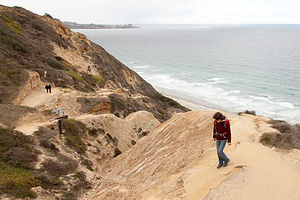 Hike Down to Torrey Pines State BeachWhile the beach at the northern end of Torrey Pines is easily accessible by car, on the southern end you have to work for. The very steep and somewhat precarious south trail switchbacks down from the Glider Port parking lot to Black’s Beach, with great views along the way. It’s only 1,000 feet long, but its 320 foot descent in that short distance, makes it feel much longer. However, the trail is well maintained and there are steps and handrails in the steeper sections.
Hike Down to Torrey Pines State BeachWhile the beach at the northern end of Torrey Pines is easily accessible by car, on the southern end you have to work for. The very steep and somewhat precarious south trail switchbacks down from the Glider Port parking lot to Black’s Beach, with great views along the way. It’s only 1,000 feet long, but its 320 foot descent in that short distance, makes it feel much longer. However, the trail is well maintained and there are steps and handrails in the steeper sections.
Once at the bottom, we headed right, or north, up the beach where the paragliders were flying overhead. This is also the clothing optional section of the beach, but clothing was definitely a necessity and not an option today.
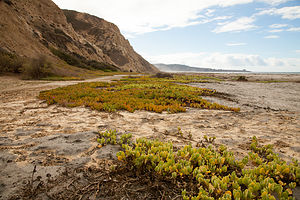 Torrey Pines State BeachWe walked down the beach about a ½ mile figuring we would retrace our steps and go back up the way we came down. That’s before we saw a man with a giant pack on his back head directly towards the cliffs and up a narrow path that we hadn’t even noticed. Perhaps, it would have been better if we hadn’t discovered this route up, because it was pretty rough for me, much more difficult than our way down. This must be the precarious north trail that I read about.
Torrey Pines State BeachWe walked down the beach about a ½ mile figuring we would retrace our steps and go back up the way we came down. That’s before we saw a man with a giant pack on his back head directly towards the cliffs and up a narrow path that we hadn’t even noticed. Perhaps, it would have been better if we hadn’t discovered this route up, because it was pretty rough for me, much more difficult than our way down. This must be the precarious north trail that I read about.
The gentleman, who was extremely friendly and nice, introduced himself as Ziggy and explained that he had run out of wind and had to land his paraglider on the beach – the preference is to continue soaring back and forth above the bluffs. We got to talking a bit more and found out that Ziggy had quite an impressive adventure resume, including activities such as mountaineering and ice climbing throughout Europe. He had only started paragliding a few years ago when he was 55. Part of me doesn’t like when Herb meets people like this, because then he feels even more driven to do things that might be beyond my fear level, but the other part of me likes to see that people our age are still so physically active and often just starting out on new adventurous hobbies.
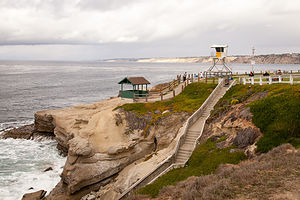 La Jolla OceanfrontOne criticism I do have about Herb is that he sometimes has what I consider a pessimistic perspective on where we are in the aging process, making me feel like a walker might be my next piece of recreational equipment. He, however, feels that we should be very aware of the fact that we are not going to be able to do the physically challenging things we like to do forever, so we should go at them with gusto while we can. I guess he is right, but I would just prefer taking this approach without thinking about why – I am perfectly willing to hide my head in the sand on this one.
La Jolla OceanfrontOne criticism I do have about Herb is that he sometimes has what I consider a pessimistic perspective on where we are in the aging process, making me feel like a walker might be my next piece of recreational equipment. He, however, feels that we should be very aware of the fact that we are not going to be able to do the physically challenging things we like to do forever, so we should go at them with gusto while we can. I guess he is right, but I would just prefer taking this approach without thinking about why – I am perfectly willing to hide my head in the sand on this one.
We parted with Ziggy at the Glider Port atop the bluff and headed into nearby La Jolla, San Diego’s most affluent neighborhood, to walk around and visit the Museum of Contemporary Art. As was expected, it was a lovely town with many fine restaurants, jewelry shops, and art galleries.
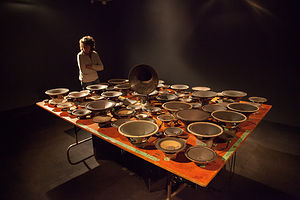 Multimedia Exhibit at Museum of Contemporary Art - La JollaOur favorite was the Peter Lik Photo Gallery. Herb had probably seen all the episodes of his TV show, “From the Edge with Peter Lik,” where this down to earth Australian adventure photographer goes anywhere and takes on any risk to get the ultimate shot. And, he usually does. That is why he now has a dozen or so galleries around the U.S., where his wide-angled, panoramic landscape photos sell for as much as $1,000,000.
Multimedia Exhibit at Museum of Contemporary Art - La JollaOur favorite was the Peter Lik Photo Gallery. Herb had probably seen all the episodes of his TV show, “From the Edge with Peter Lik,” where this down to earth Australian adventure photographer goes anywhere and takes on any risk to get the ultimate shot. And, he usually does. That is why he now has a dozen or so galleries around the U.S., where his wide-angled, panoramic landscape photos sell for as much as $1,000,000.
Needless to say, we were just window shopping, so I panicked when the sales assistant, who was very friendly and informative, and I liked him up until now, asked us, “What kind of art do you have hanging on your wall.” Herb pretended to not hear the question and slinked away, allowing me to take this one alone. I think I mumbled something incoherent and changed the subject. To get even I should have said, “Nothing, because my cheap husband won’t buy me any,” but I was above that. In hindsight, I should have said our own photos of our wonderful adventures together as a family, some of them even better than Peter Lik’s, but I couldn’t think that fast.
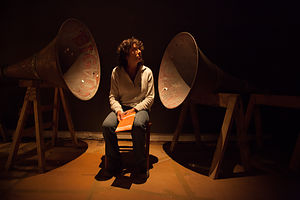 Lolo getting an Earful of Art at La Jolla Museum of Contemporary ArtOur next stop was the Museum of Contemporary Art, which is part of the San Diego Art Museum. It’s located atop a bluff above the waterfront in what was once the home of philanthropist Ellen Browning Scripps, the founding donor of such learning institutions as the Scripps Institution of Oceanography and Scripps Research Institute. The museum was quite small and at first I thought its exhibits would not keep us occupied for more than ½ hour. That was until we discovered the interactive, multimedia exhibits in the back of the museum.
Lolo getting an Earful of Art at La Jolla Museum of Contemporary ArtOur next stop was the Museum of Contemporary Art, which is part of the San Diego Art Museum. It’s located atop a bluff above the waterfront in what was once the home of philanthropist Ellen Browning Scripps, the founding donor of such learning institutions as the Scripps Institution of Oceanography and Scripps Research Institute. The museum was quite small and at first I thought its exhibits would not keep us occupied for more than ½ hour. That was until we discovered the interactive, multimedia exhibits in the back of the museum.
The first one we experienced was a box, probably about 4 ft x 4ft x 4 ft that that contained a miniature movie theater, complete with theater seats and a movie screen. When I looked into the box, I felt as if I were standing at the back of the theater looking over the other theatergoers at a movie clip being played over and over again in an endless loop. The audio was both of the movie as well as whisperings of the audience, so I kind of felt like I was eavesdropping on their conversations. It made me question what was reality and what was illusion, as I found myself being drawn into thinking I was part of the audience itself, and could, if I wanted, join in on the whisperings.
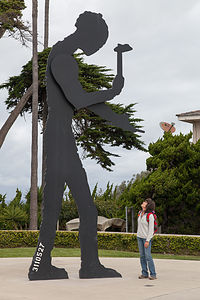 Lolo with Hammering ManIn another exhibit, we wandered around the clutter of someone’s room that must have been a hoarder. As we approached different objects, some of them would start to move, or voices would start talking. There were some objects in the room that you were allowed and even encouraged to touch, but it was hard to tell which. I was stopped by a staff member when I reached for something I shouldn’t have, so I played it safe from there on and kept my hands to myself. At one point, I sat on a chair between two large old style speakers, the kind that looked like tubas, and voices immediately and quite loudly started coming out of them. I found myself literally in the middle of a conversation between a man and a woman.
Lolo with Hammering ManIn another exhibit, we wandered around the clutter of someone’s room that must have been a hoarder. As we approached different objects, some of them would start to move, or voices would start talking. There were some objects in the room that you were allowed and even encouraged to touch, but it was hard to tell which. I was stopped by a staff member when I reached for something I shouldn’t have, so I played it safe from there on and kept my hands to myself. At one point, I sat on a chair between two large old style speakers, the kind that looked like tubas, and voices immediately and quite loudly started coming out of them. I found myself literally in the middle of a conversation between a man and a woman.
It was really quite interesting experience, much less passive than the usual museum experience, and much better than my expectations when I first entered.
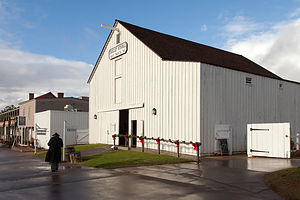 Seeley Stable MuseumThe next stop on our cook’s tour of San Diego was Cabrillo National Monument at the tip of the Point Luma Peninsula, a memorial to the site where the first European, Juan Rodriguez Cabrillo, stepped foot on the West Coast of the U.S. in 1542.
Seeley Stable MuseumThe next stop on our cook’s tour of San Diego was Cabrillo National Monument at the tip of the Point Luma Peninsula, a memorial to the site where the first European, Juan Rodriguez Cabrillo, stepped foot on the West Coast of the U.S. in 1542.
Unfortunately, by now the rain had begun in earnest and we got soaked running from our car to the Visitor Center. Too bad, because it was a very pretty spot and would have been fun to explore on a better day. We waited out the heavy rain in the Visitor Center and then walked out to the 14-foot statue of Cabrillo, located in a small circular plaza overlooking San Diego and the harbor.
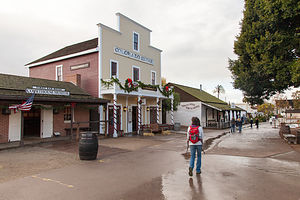 Old Town San Diego State Historic ParkIf we come back here again, which I am sure we will, the other things I would like to do are: visit the Old Point Loma Lighthouse, look for Pacific gray whales from the Whale Overlook, and hike the two-mile Bayside Trail from the lighthouse. The views along the way are supposed to be spectacular.
Old Town San Diego State Historic ParkIf we come back here again, which I am sure we will, the other things I would like to do are: visit the Old Point Loma Lighthouse, look for Pacific gray whales from the Whale Overlook, and hike the two-mile Bayside Trail from the lighthouse. The views along the way are supposed to be spectacular.
Continuing on a history theme, we drove over to the Old Town State Historic Park to see what life was like in 1872 San Diego during the period of Mexican influence. We have been to many of these living history types of villages, especially on the East Coast, where there is much more history – just kidding, but seriously the East Coast has about a 100 years at least on the West.
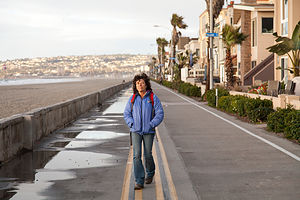 Lolo on Mission Beach BoardwalkProbably the closest East Coast parallel to Old Town that I can think of is Sturbridge Village in central Massachusetts, mostly because, like Sturbridge, many of the buildings clustered around the Old Town Plaza were really gift shops and eating establishments housed in historic buildings – not that that is a bad thing, as that is what most people are looking for.
Lolo on Mission Beach BoardwalkProbably the closest East Coast parallel to Old Town that I can think of is Sturbridge Village in central Massachusetts, mostly because, like Sturbridge, many of the buildings clustered around the Old Town Plaza were really gift shops and eating establishments housed in historic buildings – not that that is a bad thing, as that is what most people are looking for.
Probably my favorite two buildings in Old Town were the Casa de Estudillo, the elaborate adobe home and central courtyard of a wealthy Mexican family in 1862, and the Seeley Stable, an old stagecoach stop that now houses an excellent wagon and carriage collection.
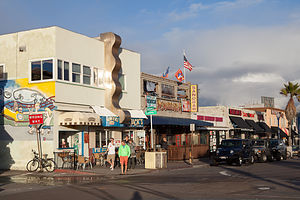 Mission Beach ShopsOur final destination in San Diego was Mission Beach, which we had missed on our bike ride the previous evening because of a wrong turn. It was extremely windy and quite cool, so we were able to easily get parking, right next to the Giant Dipper, a classic wooden roller coaster built in 1925. Unfortunately, it wasn’t running today because of the weather conditions.
Mission Beach ShopsOur final destination in San Diego was Mission Beach, which we had missed on our bike ride the previous evening because of a wrong turn. It was extremely windy and quite cool, so we were able to easily get parking, right next to the Giant Dipper, a classic wooden roller coaster built in 1925. Unfortunately, it wasn’t running today because of the weather conditions.
We took a brief stroll along the cement boardwalk that parallels the 2-mile sandy stretch of San Diego’s most popular beach. The houses on the non-ocean side of the boardwalk are so close that if I wanted to I could have reached over and grabbed the beer from the very contented looking gentleman sitting in his Jacuzzi. He didn’t seem to mind the stream of walkers, joggers, cyclists, and roller bladders whizzing by. In fact, I think it added to his experience.
That was about it for our San Diego visit. Next time, hopefully we will have warmer temperatures and sunny skies.
Description
Campland on the Bay
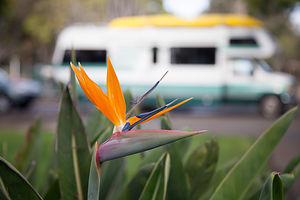 Lazy Daze at Campland on the BayCampland on the Bay is one of the largest campgrounds in California, or for that matter, the entire country. Its popularity stems from its prime location on beautiful Mission Bay and its many water activities: power boating, jet skiing, kayaking, waterskiing, deep-sea fishing, and swimming on its private beach.
Lazy Daze at Campland on the BayCampland on the Bay is one of the largest campgrounds in California, or for that matter, the entire country. Its popularity stems from its prime location on beautiful Mission Bay and its many water activities: power boating, jet skiing, kayaking, waterskiing, deep-sea fishing, and swimming on its private beach.
For those birding enthusiasts, Campland overlooks the Kendall Frost Wildlife Preserve–home to egrets, black-crowned night herons, least terns, and the endangered clapper rail.
Other amenities include: 2 swimming pools and jacuzzis, a world class fitness room, a 124-slip marina, power boat and kayak rentals, bike rentals, the Hungry Wolf BBQ and Ice Cream Parlor, and lots of planned activities on the weekends.
The campground has 558 sites, most with full or partial hookups. There is even one Super Site, complete with private patio, jacuzzi, and grill.
Side Trips from Campland on the Bay
The following is in no way intended to be a complete listing of sights to see in the San Diego area, but just those that we chose to visit during our all too short 2 day stay.
Torrey Pine State Beach
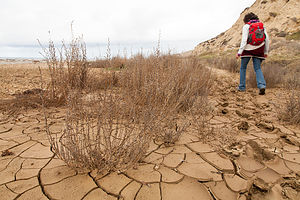 Torrey Pines State Beach ClayTorrey Pines State Beach in La Jolla extends for three miles from Carmel Valley Road in the north to the Glider Port at Torrey Pines Scenic Drive.
Torrey Pines State Beach ClayTorrey Pines State Beach in La Jolla extends for three miles from Carmel Valley Road in the north to the Glider Port at Torrey Pines Scenic Drive.
The north section of the beach is more easily accessible by car and is the choice for families.
Black’s Beach on the southern end is only accessible via two steep trails from the top of the cliff, where the parking lots are. This difficult-to-get-to beach is mostly frequented by two types: surfers looking to enjoy the huge winter swells, and nudists looking to enjoy some privacy. The nudists tend to hang out north of the Glider Port, while the surfers head to the south.
The south trail, which begins just south of the Glider Port, is easier and better maintained than the north trail, in that it has steps and handrails in the steeper segments. The north trail is much steeper and should be avoided if you are subject to vertigo. Both trails are about 1,000 feet long and have an elevation loss of about 320 feet.
It’s also fun to watch the hang gliders and paragliders soar from the Glider Port, atop the cliffs above Black Beach.
La Jolla
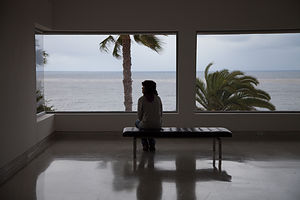 La Jolla Museum of Contemporary Art Ocean ViewThe Native Americans originally called the site La Hoya, meaning “the cave,” referring to the grottoes that dot the shoreline. When the Spaniards arrived, they changed the name to La Jolla (same pronunciation), meaning “the jewel.”
La Jolla Museum of Contemporary Art Ocean ViewThe Native Americans originally called the site La Hoya, meaning “the cave,” referring to the grottoes that dot the shoreline. When the Spaniards arrived, they changed the name to La Jolla (same pronunciation), meaning “the jewel.”
Today, La Jolla certainly is a jewel, and a very expensive one at that. With its stunning coastline and upscale restaurants, shops, and galleries along Girard and Prospect Streets, it is one of the most affluent communities in America.
The Museum of Contemporary Art San Diego is located on a bluff above the waterfront in what was once the residence of philanthropist Ellen Browning Scripps. The museum has over 4,000 works representing every major art movement of the past half century, with a particularly strong emphasis on California artists.
The University of California, San Diego is located in La Jolla, as well as the Scripps Institution of Oceanography, Scripps Research Institute, and Salk Institute.
Cabrillo National Monument
Located at the tip of the Point Luma Peninsula in San Diego, the Cabrillo National Monument marks the site where in 1542 Juan Rodriguez Cabrillo became the first European to set foot on the West Coast of the United States. The Visitor Center has an “Age of Exploration” exhibit and film.
Near the Visitor Center is a small circular plaza with a 14-foot statue of the explorer. The Plaza has an excellent view of San Diego and the harbor.
A short walk from there leads to the Old Point Loma Lighthouse, the highest point in the park. The lighthouse and adjacent Assistant Keepers’ Quarters has exhibits presenting what life was like for the lighthouse keepers in the 1880s.
Just south of the lighthouse is the Whale Overlook, a prime vantage point for viewing migrating Pacific gray whales traveling back and forth between Alaska and Baja California during the months of December through March.
The self-guided, two-mile Bayside Trail begins near the lighthouse and leads visitors through one of the last remaining remnants of a coastal sage scrub forest in the world. This trail offers views of San Diego harbor and the city beyond.
Old Town San Diego State Historic Park
The Old Town State Historic Park, which occupies six square blocks on the site of San Diego’s original pueblo, is dedicated to recreating what life was like in the city during the era of Mexican influence, from 1821 to 1872.
20 historic buildings, a few of which are original, are clustered around the Old Town Plaza. Some of the more noteworthy ones include:
- Robinson-Rose House – built in 1853, this was the original commercial center of Old Town, housing railroad offices, law offices, and the first newspaper press. Today it serves as the Park’s’ Visitor Center and contains a model of what Old Town looked like in 1872
- Casa de Estudillo – the largest and most elaborate of the adobe homes in the park, this one provides a good example of the living conditions of a wealthy family in 1872
- Seeley Stable – this served as a stagecoach stop until 1887, when trains became the preferred mode of transportation. Today it houses an excellent wagon and carriage collection.
- Cosmopolitan Hotel and Restaurant – in 1869 Albert Seeley, a stagecoach entrepreneur purchased this home and turned it into a hotel serving as a way station for travelers making the daylong trip south from Los Angeles.
On Wednesdays and Saturdays, costumed volunteers reenact 19th century life with blacksmithing, cooking, and craft demonstrations.
Mission Beach
The two-mile sandy stretch from the northern entrance of Mission Bay to Pacific Beach is San Diego’s most popular beach. A wide cement boardwalk parallels the beach and is popular with cyclists, joggers, walkers, and rollerbladers.
One of the most prominent features of Mission Beach is the Giant Dipper, a wooden roller coaster built in 1925. This and its twin on the Santa Cruz Beach Boardwalk are the only remaining roller coasters on the West Coast built by the noted coaster builders, Prior and Church.
Malibu Beach RV Park
Wednesday, December 4, 2013 - 12:00pm by Lolo185 miles and 3.5 hours from our last stop - 2 night stay
Travelogue
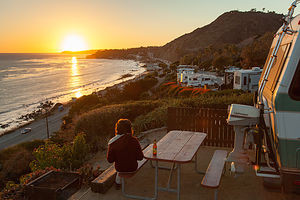 Malibu Beach RV Park SunsetIn all our travels, I would have to say that we have never had a better view from a campsite than the one we had from ours at the Malibu Beach RV Park -- and that includes the national park campgrounds as well. Surprisingly, it was only given a scenic rating of 7 in our West Coast RV Camping Guide, which now makes me somewhat skeptical about their ratings. What were they thinking? Maybe they base it totally on natural beauty, and there were a few too many mutlimillion dollar beach houses obstructing the incredible view of the ocean and shoreline, positioned in such a way that amazingly both sunrise and sunset occurred over the ocean.
Malibu Beach RV Park SunsetIn all our travels, I would have to say that we have never had a better view from a campsite than the one we had from ours at the Malibu Beach RV Park -- and that includes the national park campgrounds as well. Surprisingly, it was only given a scenic rating of 7 in our West Coast RV Camping Guide, which now makes me somewhat skeptical about their ratings. What were they thinking? Maybe they base it totally on natural beauty, and there were a few too many mutlimillion dollar beach houses obstructing the incredible view of the ocean and shoreline, positioned in such a way that amazingly both sunrise and sunset occurred over the ocean.
Also, the campground was very reasonably priced, at least off season as it was. For a partial hookup with ocean view it cost us only $40 per night -- $5 more than sites without a view. I would have paid a lot more than $5 for this view, but was certainly glad we didn’t have to.
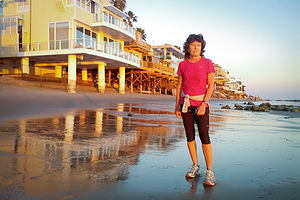 Lolo on Malibu Beach RunAs we often do when arriving at a new place, Herb and I set out on an exploratory run. At first we tried the Coral Canyon Trail, which started right from the campground, but the trail was so ridiculously narrow, overgrown, and steep that we quickly abandoned that idea and worked our way down to the Pacific Coast Highway with the intention of running along the beach. Not such an easy thing either, as most of Malibu Beach is privately owned, by people that very much want their privacy. However, after running for about ¾ of a mile on this way too busy road, we found a public access point and then proceeded to run along the beach, past the houses of the rich and famous, being careful to stay below the high tide line, which we figured was fair game. Property rights, we hoped, only extended to the high tide line. It was beautiful. The sun was getting low and the lighting was great. The houses weren’t too bad either, but I am always amazed when multimillion dollar houses are so close together that you can probably hear your neighbor cough. I guess the land is too valuable to waste on anything but opulent square footage.
Lolo on Malibu Beach RunAs we often do when arriving at a new place, Herb and I set out on an exploratory run. At first we tried the Coral Canyon Trail, which started right from the campground, but the trail was so ridiculously narrow, overgrown, and steep that we quickly abandoned that idea and worked our way down to the Pacific Coast Highway with the intention of running along the beach. Not such an easy thing either, as most of Malibu Beach is privately owned, by people that very much want their privacy. However, after running for about ¾ of a mile on this way too busy road, we found a public access point and then proceeded to run along the beach, past the houses of the rich and famous, being careful to stay below the high tide line, which we figured was fair game. Property rights, we hoped, only extended to the high tide line. It was beautiful. The sun was getting low and the lighting was great. The houses weren’t too bad either, but I am always amazed when multimillion dollar houses are so close together that you can probably hear your neighbor cough. I guess the land is too valuable to waste on anything but opulent square footage.
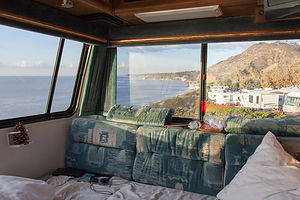 Malibu Beach RV Park view from Lazy DazeBy the time we got back to the campsite, the sun was just dipping into the sea, but we would be here for another night, so perhaps we could get some better photos the following evening.
Malibu Beach RV Park view from Lazy DazeBy the time we got back to the campsite, the sun was just dipping into the sea, but we would be here for another night, so perhaps we could get some better photos the following evening.
One of the reasons we selected this campground, even before we knew about the view, was its proximity to the Getty Villa. As I mentioned, the weather had turned considerably colder, transforming our sunny Southern California sojourn into more of a museum tour. Not such a hardship though, as the Getty Villa and Getty Center were places we very much wanted to visit anyway.
We spent the following day visiting both (see next stop) before returning to this campground to enjoy a more leisurely sunset.
Description
Malibu Beach RV Park
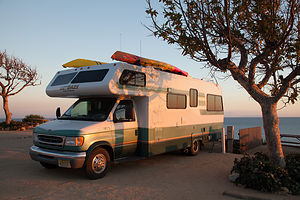 Malibu Beach RV Park Lazy Daze on BluffThe Malibu Beach RV Park is located on Highway 1 between the Malibu Pier and Paradise Cove. This lovely campground is perched atop a bluff overlooking the Pacific Ocean and the world famous Malibu Beach. Since it faces south over the ocean, both sunrise and sunset are viewable from the campground.
Malibu Beach RV Park Lazy Daze on BluffThe Malibu Beach RV Park is located on Highway 1 between the Malibu Pier and Paradise Cove. This lovely campground is perched atop a bluff overlooking the Pacific Ocean and the world famous Malibu Beach. Since it faces south over the ocean, both sunrise and sunset are viewable from the campground.
There are 140 RV sites with full or partial hookups. Other amenities include a spa, recreation room, WiFi, and cable TV.
Morro Bay State Park and San Luis Obispo
Tuesday, December 3, 2013 - 12:00pm by Lolo32 miles and 0.75 hours from our last stop - 1 night stay
Travelogue
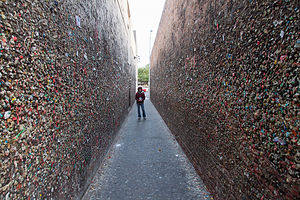 Lolo in Bubblegum AlleyThe weather had already begun to turn when we were up at Hearst Castle, but by the time we reached Morro Rock temperatures had dropped significantly and the winds were picking up, so much so that we couldn’t get out of the car to photograph the Rock without being pelted by sand—not exactly very conducive conditions for our plans of kayaking in Morro Bay.
Lolo in Bubblegum AlleyThe weather had already begun to turn when we were up at Hearst Castle, but by the time we reached Morro Rock temperatures had dropped significantly and the winds were picking up, so much so that we couldn’t get out of the car to photograph the Rock without being pelted by sand—not exactly very conducive conditions for our plans of kayaking in Morro Bay.
Part of our motivation for driving south along the coast was to get a chance to use our much neglected kayaks. The two places we had picked to use them were Morro Bay and the La Jolla Sea Caves. Needless to say, the weather was definitely not going to allow us to kayak in Morro Bay, and unfortunately, the forecast didn’t look to promising for La Jolla in a few days either. How ironic that we were able to kayak in the Russian River in Northern California last week, and were now being thwarted in Southern California. This was all feeding into Andrew and Tommy’s plan for us to eventually move to Northern California rather than Southern, where my sun-worshipping husband hoped to find a warmer climate.
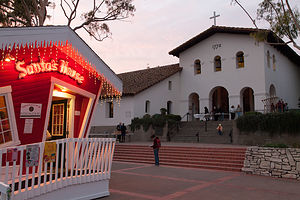 Santas House at Mission San Luis ObispoSo, instead we had to content ourselves with admiring the Rock through our sand-covered car window. It really was a very impressive rock, or more correctly a volcanic plug, known as a “morro.” In fact, there are nine morros called the Nine Sisters that form a chain between Morro Bay and San Luis Obispo. This one is the most well known and photographed though, because it stands in the entrance to the harbor, while the rest are on land. You can drive right up to this 576-foot beast over a short causeway, but you’re not allowed to climb on it because it is home to endangered peregrine falcons.
Santas House at Mission San Luis ObispoSo, instead we had to content ourselves with admiring the Rock through our sand-covered car window. It really was a very impressive rock, or more correctly a volcanic plug, known as a “morro.” In fact, there are nine morros called the Nine Sisters that form a chain between Morro Bay and San Luis Obispo. This one is the most well known and photographed though, because it stands in the entrance to the harbor, while the rest are on land. You can drive right up to this 576-foot beast over a short causeway, but you’re not allowed to climb on it because it is home to endangered peregrine falcons.
Hoping to have a better shot at it the next day, we drove into Morro Bay State Park, right near the bay, where we planned to camp for the night. When we told the ranger at the entrance booth that we had just been to Hearst Castle, he told us that the State Park employees were having their holiday party there that night. I was so envious. I mean the tour was great, but I am sure nothing compared to having the run of the place. I wonder if they get to swim in the Roman pool.
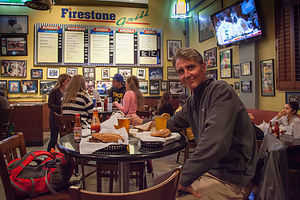 58 Year Old Herb at Firestone GrillOne of my major reasons for stopping here, other than the hope of kayaking, was to see the nearby town of San Luis Obispo, which we had heard so many good things about. Herb and I will eventually move to the West Coast and we are always on the lookout for possible places to live. A college town is pretty much a must for us, for the culture and liveliness, so Cal Poly put this one in the running.
58 Year Old Herb at Firestone GrillOne of my major reasons for stopping here, other than the hope of kayaking, was to see the nearby town of San Luis Obispo, which we had heard so many good things about. Herb and I will eventually move to the West Coast and we are always on the lookout for possible places to live. A college town is pretty much a must for us, for the culture and liveliness, so Cal Poly put this one in the running.
As we always do when exploring a new place, we consulted our guidebooks and came up with a few things we’d like to see – in this case, the Mission San Luis Obispo de Tolosa and Bubblegum Alley, which admittedly fell on opposite ends of the cultural and historical significance spectrum. Since our visit to Seattle’s Bubblegum Alley, I have changed my view of this form of public art from “Oh, gross,” to “Oh, look at how the various colors and the textures play off each other.”
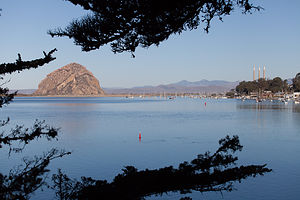 Morro Rock with SmokestacksWe thought finding the Alley might be tough, but ironically, after searching for parking, we finally found a spot on Higuera Street, literally right in front of it. There certainly was a lot of chewed gum on display in this 15 foot high, 70 foot long alley. I wonder how many cavities it is responsible for.
Morro Rock with SmokestacksWe thought finding the Alley might be tough, but ironically, after searching for parking, we finally found a spot on Higuera Street, literally right in front of it. There certainly was a lot of chewed gum on display in this 15 foot high, 70 foot long alley. I wonder how many cavities it is responsible for.
Our next stop was the Mission San Luis Obispo de Tolosa, one of the string of missions established in California by the Spanish back in the late 1800s. There was plenty of activity around Mission Plaza that night, as Christmas was coming and Santa had set shop in the Plaza. Herb wanted to move on and explore the rest of the town, but I kept stalling because I wanted to hear the mission bells on the hour, and it was just a few minutes shy of 7:00.
It was so festive in the Plaza, and I was finally beginning to get in the Christmas mood, which was hard for me being so far from home and in places that had palm trees rather than Douglas firs.
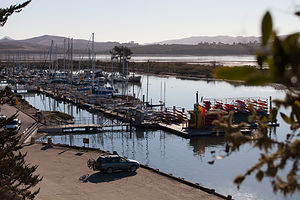 Moro Bay State Park MarinaAfter the bells, we strolled through town, taking note of the fact that it felt real and not just a tourist trap.
Moro Bay State Park MarinaAfter the bells, we strolled through town, taking note of the fact that it felt real and not just a tourist trap.
We went for dinner at the Firestone Grill for Herb’s birthday dinner, a place that had been highly recommended to us by the man who filled our propane tanks earlier in the day. The place was noisy and fun, and obviously a hangout for Cal Poly students. As per our propane man’s recommendation, we ordered the tri-tip steak sandwiches, and while we were waiting for them, I went to the bar to order us some Hefeweizen (Herb) and a Firestone IPA (me). I couldn’t believe it when the bar bill was only $5. No wonder the Cal Poly students hang out here. The tri-tip sandwich did not disappoint and we had a very fun evening.
The next morning, before continuing south, we tried once more to photograph Morro Rock. This time instead of driving out on the causeway to the base of it, we hiked the short trail from the marina up to the State Park’s Museum of Natural History on top of the hill. From here, depending on how you framed it, you could either get the pristine natural beauty of the rock rising from the waters of the bay, or swing a little to the right and include the unsightly smokestacks of the power plant rising from the shore – a very odd and incongruous partnership indeed.
Description
Morro Bay State Park
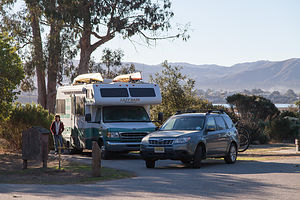 Moro Bay State Park CampgroundMorro Bay State Park is located on Morro Bay, 15 miles northwest of San Luis Obispo along scenic Highway 1. There is a 95-site campground in the park, 27 of which have partial hookups.
Moro Bay State Park CampgroundMorro Bay State Park is located on Morro Bay, 15 miles northwest of San Luis Obispo along scenic Highway 1. There is a 95-site campground in the park, 27 of which have partial hookups.
The most prominent feature in the area is Morro Rock, a 576 foot high volcanic plug that stands at the entrance to the harbor. This is one of nine “morros” or volcanic peaks that form a chain between Morro Bay and San Luis Obispo. There is a short causeway connecting the rock with the shore, but climbing on the rock itself is prohibited, because it is a reserved for the endangered peregrine falcon.
The calm waters of the bay are perfect for fishing, kayaking, and birdwatching. There are more than 15 miles of protected waters in the beautiful Morro Bay Estuary / Bird Sanctuary, which is home to California sea lions, harbor seals, sea otters, brown pelicans, and peregrine falcons.
The most popular hike in the park is to the 640-foot summit of Black Hill, one of the nine morros, from which there are spectacular views of Morro Bay and the nearby hills of Montana de Oro.
San Luis Obispo
San Luis Obispo is located at the junction of Highway 1 and US 101. Sometimes referred to as a “little Santa Barbara,” It is tucked into the mountains about halfway between Los Angeles and San Francisco.
Like many other towns and cities in California, San Luis Obispo was first established as a Spanish mission by Spanish Franciscan friars in 1772. Today the Mission San Luis Obispo de Tolosa is still an active church. The former friars’ quarters is now a small museum with artifacts from the Chumash Indians and the early Spanish settlers.
Today, the town’s main appeal is its charming, pedestrian-friendly downtown, with fine shops, galleries, and restaurants. Mission Plaza, with its brick paths and park benches along a creek, serves as the town square, often hosting festivals and concerts. During the school year the town bustles with students from California Polytechnic State University, more popularly known as Cal Poly.
San Simeon State Park and Hearst Castle
Monday, December 2, 2013 - 11:15am by Lolo239 miles and 5 hours from our last stop - 1 night stay
Travelogue
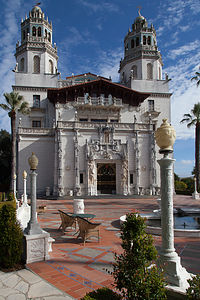 Hearst CastleNow that the boys were back to work after our wonderful Thanksgiving together in Yosemite, Herb and I were on own to explore the southern coast of California. With 9 days ahead of us before our flight back to New Jersey, we figured we would mosey on down to San Diego, making stops at interesting places along the way.
Hearst CastleNow that the boys were back to work after our wonderful Thanksgiving together in Yosemite, Herb and I were on own to explore the southern coast of California. With 9 days ahead of us before our flight back to New Jersey, we figured we would mosey on down to San Diego, making stops at interesting places along the way.
I had always wanted to see Hearst Castle, so that was first on our list. A quick consultation of our West Coast RV Camping Bible pointed us towards San Simeon State Park, just 5 miles south of Hearst Castle.
As much as I would have loved to see Monterey and Carmel again, we decided to drive down US 101 rather than Route 1 from Pacifica to San Simeon, as that section of Route 1 is a little nerve-racking in an RV. Besides, we would be back to the Bay Area so many times in the future now that Andrew lives in San Francisco that we could save that for a future trip when we could do it by car.
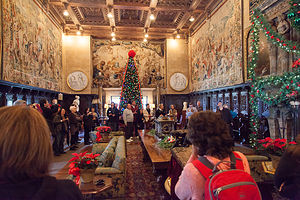 Hearst Castle Great RoomSan Simeon State Park was a great find, not just because of its proximity to the Castle, but because it was beautiful in its own right. There are two campgrounds to choose from in the park – one just across the road from the beach that has showers and costs $35 a night, and the Washburn Primitive Campground, a mile further inland on the top of a plateau overlooking the ocean and the Santa Lucia Mountains, with no showers for $20 a night. We chose Washburn, not for the $15 savings, but because of the views, and the fact that there was a trail to run on right from the campground to the beach.
Hearst Castle Great RoomSan Simeon State Park was a great find, not just because of its proximity to the Castle, but because it was beautiful in its own right. There are two campgrounds to choose from in the park – one just across the road from the beach that has showers and costs $35 a night, and the Washburn Primitive Campground, a mile further inland on the top of a plateau overlooking the ocean and the Santa Lucia Mountains, with no showers for $20 a night. We chose Washburn, not for the $15 savings, but because of the views, and the fact that there was a trail to run on right from the campground to the beach.
 Hearst Castle Dining RoomWith the days so short this time of year, we really had to get all outdoor activities in my 4:30 or 5:00, which was really pretty annoying. So, we quickly got on our running clothes and headed out on the San Simeon Creek Trail, which led us from our nice Monterey pine covered ridge down a steep trail along the creek to a boardwalk across a wetland and out to the beach. Once on the beach, we ran south for awhile before making the steep climb back through the forest. We arrived back at our campsite just in time to watch the sun dip behind the mountains.
Hearst Castle Dining RoomWith the days so short this time of year, we really had to get all outdoor activities in my 4:30 or 5:00, which was really pretty annoying. So, we quickly got on our running clothes and headed out on the San Simeon Creek Trail, which led us from our nice Monterey pine covered ridge down a steep trail along the creek to a boardwalk across a wetland and out to the beach. Once on the beach, we ran south for awhile before making the steep climb back through the forest. We arrived back at our campsite just in time to watch the sun dip behind the mountains.
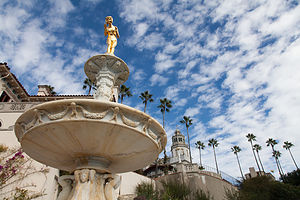 Hearst Castle Gold Girl in FountainThe next morning we were off to Hearst Castle for our 10:00 tour, which we had booked online the previous day – a smart thing to do because of the extreme popularity of these tours, which often book up days in advance. There are three different tours offered: the Grand Rooms, the Upstairs Suites, and the Cottages and Kitchens. We chose the Grand Rooms, the one recommended for first time visitors. However, we did notice that several of our fellow tourists had booked multiple tours, which wasn’t a bad idea. There’s also an Evening Tour where docents dress up in period costumes and make you feel that you are a guest at the castle. That one sounded really cool, but Herb wanted to photograph the Castle during the day – perhaps, next time.
Hearst Castle Gold Girl in FountainThe next morning we were off to Hearst Castle for our 10:00 tour, which we had booked online the previous day – a smart thing to do because of the extreme popularity of these tours, which often book up days in advance. There are three different tours offered: the Grand Rooms, the Upstairs Suites, and the Cottages and Kitchens. We chose the Grand Rooms, the one recommended for first time visitors. However, we did notice that several of our fellow tourists had booked multiple tours, which wasn’t a bad idea. There’s also an Evening Tour where docents dress up in period costumes and make you feel that you are a guest at the castle. That one sounded really cool, but Herb wanted to photograph the Castle during the day – perhaps, next time.
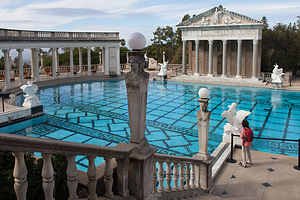 Hearst Castle Neptune Pool EntranceWe had about a ½ to kill before our tour, so we explored the very informative exhibits in the Visitor Center where we learned a great deal about the man himself, William Randolph Hearst, as well as about the history of his castle. Good, I felt prepped for my tour.
Hearst Castle Neptune Pool EntranceWe had about a ½ to kill before our tour, so we explored the very informative exhibits in the Visitor Center where we learned a great deal about the man himself, William Randolph Hearst, as well as about the history of his castle. Good, I felt prepped for my tour.
Without giving everything away, the following is a very brief summary of its history:
Back in 1865, William Randolph Hearst’s father George purchased 40,000 acres of ranchland in San Simeon, which eventually grew to 250,000 acres by the time of his death in 1919. William, a wealthy man in his own right from his vast publishing empire, inherited the land and immediately began dreaming of transforming it into a retreat. For its location, he chose the solitary top of a hill, which he named la Cuesta Encantada, the Enchanted Hill. For 30 years and $25 million, Hearst and his architect Julia Morgan worked on designing what you see today – the 115-room, Mediterranean Revival style Castle and its surrounding 127 acres of gardens, terraces, pools, and walkways. Plus, three guest "cottages." The design also incorporated his extensive art collection, much of which is on display both in the mansion as well as in the surrounding gardens and terraces. During the 1920s and 1930s, this opulent estate became a gathering place for many Hollywood and political elites, such as Cary Grant, James Stewart, Bob Hope, Charlie Chaplin, the Marx Brothers, Franklin Roosevelt, Calvin Coolidge, Winston Churchill, and more. In 1957, the Hearst family donated the estate to the state of California, and that is why we are fortunate enough to be one of Hearst’s guests today.
 Hearst Castle Neptune PoolOkay, now that we are all up to speed somewhat, it’s time to join the bus for an incredible five-mile steep and windy journey up to the Castle atop the Enchanted Hill. As far as I was concerned, this ride was already worth my $25 price of admission. The views of the castle, the San Lucia Mountains, and the Pacific Ocean were breathtaking. An audio narration by Alex Trebek added to the trip as well.
Hearst Castle Neptune PoolOkay, now that we are all up to speed somewhat, it’s time to join the bus for an incredible five-mile steep and windy journey up to the Castle atop the Enchanted Hill. As far as I was concerned, this ride was already worth my $25 price of admission. The views of the castle, the San Lucia Mountains, and the Pacific Ocean were breathtaking. An audio narration by Alex Trebek added to the trip as well.
Once atop the hill, we were greeted by our docent who would for the next 45 minutes lead us through various parts of the castle and estate, which in this tour included the Assembly Room, Refectory, Billiard Room, Theater, Gardens, Neptune Pool, and Roman Pool. Our docent was great and it seemed that his family had had some connection with William Randolph Hearst.
 Hearst Castle Neptune PoolI absolutely love mansion tours, mostly because I like to peek into other people’s lives, especially when they are as interesting as William Randolph Hearst. The guided tour lasted 45 minutes, and then we were left to explore the estate on our own, which was probably the best part.
Hearst Castle Neptune PoolI absolutely love mansion tours, mostly because I like to peek into other people’s lives, especially when they are as interesting as William Randolph Hearst. The guided tour lasted 45 minutes, and then we were left to explore the estate on our own, which was probably the best part.
Besides the castle itself, the estate also includes three “cottages” connected by a series of terraces and walkways. Everything is relative. One man’s cottage is another man’s mansion, because these were beautiful. Each of them was named based on their view. The one facing the sea, and the largest of the group, was called Casa del Mar. The Casa del Monte faced the Santa Lucia Mountains and the Casa del Sol appropriately faced the sunset.
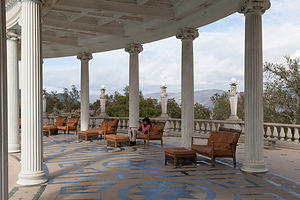 Lolo at Hearst Castle Neptune PoolProbably my highlight was the Neptune Pool. This is probably the most photographed part of the estate, and it’s easy to see why. Not only was the Greco-Roman themed pool beautiful, but the expansive views out over the mountains and ocean from its terrace were breathtaking as well. What decadence! There was even a replica of an ancient Roman temple.
Lolo at Hearst Castle Neptune PoolProbably my highlight was the Neptune Pool. This is probably the most photographed part of the estate, and it’s easy to see why. Not only was the Greco-Roman themed pool beautiful, but the expansive views out over the mountains and ocean from its terrace were breathtaking as well. What decadence! There was even a replica of an ancient Roman temple.
For those cooler days, Hearst also had an indoor pool for his guests to enjoy, modeled after the Baths of Caracalla in ancient Rome. Everyone should have one. Before seeing this, I never would have believed that an indoor pool could be so beautiful – it’s amazing what a little money can do; it’s even more amazing what a lot of money can do.
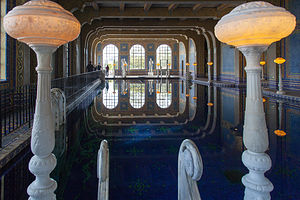 Hearst Castle Indoor PoolThe whole effect of the design was stunning. Blue and orange glass mosaic tiles covered the walls and arches, creating a shimmering effect in the water. The roof and dome were a mosaic of night blue, with the appropriate scattering of stars, making you feel that you were looking up at a clear night sky rather than sniffing chlorine around an indoor pool in the middle of the day. To complete the effect, blue and orange alabaster-carved globe lamps emitted a glow, creating the illusion of moonlight. It really was incredible.
Hearst Castle Indoor PoolThe whole effect of the design was stunning. Blue and orange glass mosaic tiles covered the walls and arches, creating a shimmering effect in the water. The roof and dome were a mosaic of night blue, with the appropriate scattering of stars, making you feel that you were looking up at a clear night sky rather than sniffing chlorine around an indoor pool in the middle of the day. To complete the effect, blue and orange alabaster-carved globe lamps emitted a glow, creating the illusion of moonlight. It really was incredible.
One of the tour guides standing around the pool told us that on one really, really hot day, after all the tours were complete, they were allowed to jump in this pool to cool off. Now that would have been something.
Having seen all we were able to see of this incredible estate, we joined Alex Trebek for the bus ride back down the mountain.
Description
San Simeon State Park
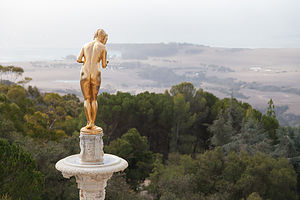 Hearst Castle OverlookSan Simeon State Park is located 35 miles north of San Luis Obispo along scenic Highway 1. Its 541 acres encompass two miles of rocky coastline, a Monterey pine forest, three natural preserves, and two campgrounds. The views inland of the Santa Lucia Mountains are spectacular. The 3.3 mile San Simeon Creek trail runs through the park from the Washburn campground, along the creek, and down to and along the beach.
Hearst Castle OverlookSan Simeon State Park is located 35 miles north of San Luis Obispo along scenic Highway 1. Its 541 acres encompass two miles of rocky coastline, a Monterey pine forest, three natural preserves, and two campgrounds. The views inland of the Santa Lucia Mountains are spectacular. The 3.3 mile San Simeon Creek trail runs through the park from the Washburn campground, along the creek, and down to and along the beach.
The park has two campgrounds set across the highway from the beach. San Simeon Creek Campground has 134 sites and the Washburn Primitive Campground has 70 sites. The Washburn Campground is located approximately one mile inland from the beach on a plateau overlooking the Santa Lucia Mountains and the ocean.
The Park’s major draw is its proximity to Hearst Castle, just 5 miles north of the campground.
Hearst Castle
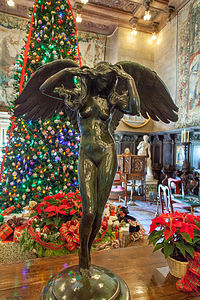 Hearst Castle at ChristmasHearst Castle is the famous 165-room estate of publishing magnate William Randolph Hearst. This magnificent “castle” sits in solitary splendor atop a hill, which Hearst named la Cuesta Encantada, the Enchanted Hill.
Hearst Castle at ChristmasHearst Castle is the famous 165-room estate of publishing magnate William Randolph Hearst. This magnificent “castle” sits in solitary splendor atop a hill, which Hearst named la Cuesta Encantada, the Enchanted Hill.
Its history began in 1865, when Hearst’s father, George Hearst, purchased 40,000 acres of ranchland. By the time of George’s death in 1919, the ranch had grown to 250,000 acres, all of which were inherited by his son William, who immediately began dreaming of ways to transform it into a retreat. For almost 30 years and $10 million, Hearst and his architect Julia Morgan, worked to create the Castle itself and 127 acres of gardens, terraces, pools, and walkways.
Hearst was very much personally involved in the estate’s design, which is a blend of Italian, Spanish, and Moorish styles. His legendary art collection, which rivals many museums, is on display both in the mansion, as well as in the gardens and terraces surrounding it.
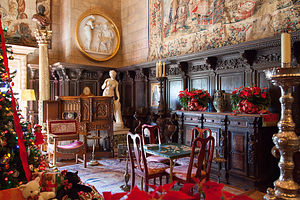 Hearst Castle Great Room DetailThe estate also includes three opulent guest houses, each focusing on a different view. Casa del Mar, the largest of the three, faces the sea, Casa del Monte looks out over the Santa Lucia Mountains, and Casa del Sol faces the sunset. The three “cottages” are connected by terraces and staircases and surrounded by gardens and sculptures.
Hearst Castle Great Room DetailThe estate also includes three opulent guest houses, each focusing on a different view. Casa del Mar, the largest of the three, faces the sea, Casa del Monte looks out over the Santa Lucia Mountains, and Casa del Sol faces the sunset. The three “cottages” are connected by terraces and staircases and surrounded by gardens and sculptures.
A highlight of the estate is the outdoor Greco-Roman Neptune Pool, perched at the edge of the hilltop, with expansive views of the mountains and sea. The pool patio features an ancient Roman temple supported by ancient Roman columns dating from the 1st to 4th century. Marble statues of Nymphs and Swans surround the pool.
There is also an indoor pool, styled after an ancient Roman bath, surrounded by eight Carrara-marble statues of Roman gods, goddesses, and heroes. The entire room is decorated with glass mosaic tiles of blue, orange, and clear fused with gold inside, creating a shimmering effect. The roof and dome are covered with mosaics of night blue, powdered with stars, while blue and orange-colored Alabaster globe lamps create the illusion of moonlight. The whole effect is breathtaking.
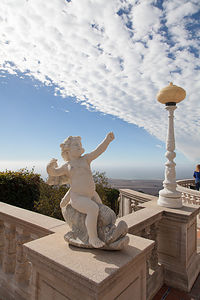 Hearst Castle CupidWith its beautiful art work, gardens, terraces, and pools, it is no wonder that an invitation to visit the Castle was highly coveted. In its heyday during the 1920s and 1930s, the Castle was the playground of many Hollywood and political elites, such as Cary Grant, James Stewart, Bob Hope, Charlie Chaplin, the Marx Brothers, Franklin Roosevelt, Calvin Coolidge, Winston Churchill, and more.
Hearst Castle CupidWith its beautiful art work, gardens, terraces, and pools, it is no wonder that an invitation to visit the Castle was highly coveted. In its heyday during the 1920s and 1930s, the Castle was the playground of many Hollywood and political elites, such as Cary Grant, James Stewart, Bob Hope, Charlie Chaplin, the Marx Brothers, Franklin Roosevelt, Calvin Coolidge, Winston Churchill, and more.
William Randolph Hearst and his Castle were also the inspiration for the 1941 movie Citizen Kane, which painted a rather unflattering picture of William Randolph Hearst. The mansion in the movie was called “Xanadu.”
In 1957, the Hearst family donated the estate to the state of California. As part of the California State Park system, it is open to the public for tours. Ticket reservations are recommended.
There are three different tours offered: Grand Rooms, Upstairs Suites, and Cottages and Kitchen. In the spring and fall, a longer Evening Tour, where docents in period costume portray Hearst’s guests, is also offered.
Tours begin at the visitor center at the foot of Enchantment Hill, where visitors can watch a 40-minute film about William Randolph Hearst’s life before riding the bus up the steep, zigzagging road to the Castle. Tours take about 2 hours, including time at the end to explore the castle grounds.
